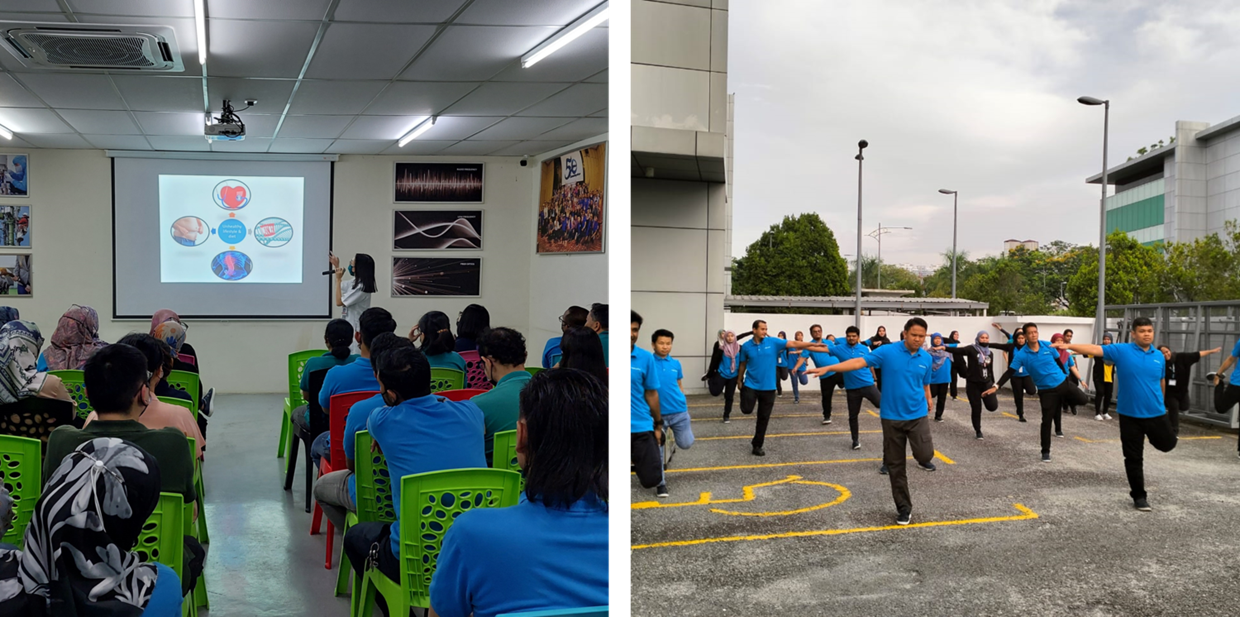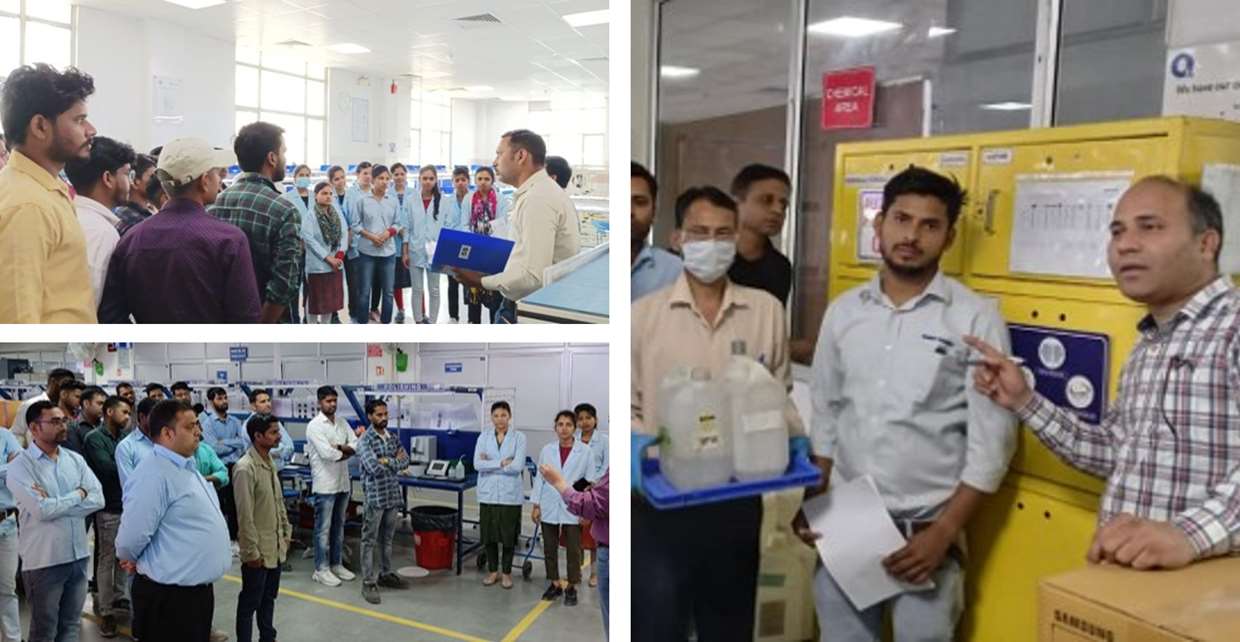Occupational health and safety
As a manufacturing company, HUBER+SUHNER regards employees’ occupational health and safety (OH&S) as a priority and a material topic. We have a global Health and Safety Policy and apply the principles established by the International Labour Organization (ILO). HUBER+SUHNER strives proactively to prevent employees from having accidents at work and leisure, as well as from developing occupational diseases and their consequences.
Approach
Occupational health and safety management
HUBER+SUHNER ensures OH&S through strict adherence to local laws and regulations and to three global processes that were introduced at the end of 2020 and subsequently rolled out. Our global Health and Safety Policy is applied throughout our operations. Every plant has health and safety officers on duty to conduct regular trainings and walk-throughs which sensitise employees to both work-related hazards and health-related topics in general. With the participation and consultation of workers, we are able to identify hazards and assess workplace risks and seize opportunities early on in order to eliminate hazards before they become incidents.
Safe and legally compliant handling of hazardous material
To protect our employees as well as the environment when handling hazardous materials, we:
- Comply with all applicable laws and regulations in the respective countries
- Ensure that manufacturers and importers of hazardous materials provide information and instructions for safe handling, including the Globally Harmonized System of Classification and Labelling of Chemicals (GHS) hazard pictograms, hazard statements, and precautionary statements
- Request the safety data sheet [1] (SDS) from the supplier, preferably in the local language. The sites’ environmental health and safety (EHS) specialists must ensure that SDSs for all chemicals used are filed in such a way that they are easily understandable and accessible to all affected employees.
Guiding principles when handling hazardous materials
To constantly minimise risks associated with the handling of hazardous materials, we adhere to the following principles:
- If possible, replace hazardous materials with non-hazardous ones
- Keep hazardous materials stock as low as possible
- Strictly observe manufacturers’ instructions on packaging and SDS, ensure translations into local languages, and train operators
- Organise warehouses in a legally compliant manner (containers, infrastructures, separated storage, stock list, etc.)
- Provide workers with personal protective equipment and ensure it is correctly worn
- For new purchase orders, ensure the most recent SDS is provided/downloaded from the supplier’s website
- Check SDS for updates/changes and inform affected employees accordingly.
A global action plan and process board
The company has developed a global action plan to ensure globally aligned OH&S management.
All sites with production and/or warehousing activities are required to establish and maintain an OH&S management system. Internal audits continuously verify the effectiveness and efficiency of the OH&S processes and system, which are aligned with the requirements defined under ISO 45001.
Currently, only our production sites in Changzhou and Shanghai, China, are TÜV SÜD-certified according to ISO 45001 and underwent a recertification in 2023. Our mid-term ambition is however to have all major production sites certified according to ISO 45001.
In 2023, the Global OH&S Process Board, established in 2022, continued its work with a focus on more proactive approaches and professional practises. Annual OH&S targets, along with detailed management programmes, were set for all sites. These are regularly monitored to track the O&HS performance and to proactively identify and control hazards to improve incident and injury prevention. Special attention was paid to adapting management processes to identify and mitigate any potential hazards.
We monitor our performance according to three key figures:
- The absence rate due to sickness
- The lost-time injury rate
- The lost-time injury severity rate
- Fatalities
Objectives
We want to continue to ensure our employees’ OH&S with the following objectives:
- We continue to work on lowering our lost-time injury rate per 1 million hours worked
- We aim to be below the Swiss manufacturing sector’s average absence rate
- We continue to work on lowering our lost-time injury frequency rate in production
- We want to pursue a zero work-related fatalities target
Progress
Absence rate
3.9 %
absence rate due to sickness
Lost-time injury frequency rate
4.1
lost-time injury frequency rate in production
The lost-time injury frequency rate [4] for our employees in production (according to GRI disclosure 403-9) stayed at 4.1 in 2023 (PY 4.1), with ten sites reporting zero lost-time injuries.
Data and targets related to lost-time injuries are published only for direct and indirect production employees, as lost-time injuries among office employees are very rare and would skew the published figures.
Table 6: Lost-time injury frequency rate
|
Year |
|
Lost-time injuries |
|
Number of hours worked in production |
|
Lost-time injury frequency rate |
|
2020 |
|
25 |
|
6 127 312 |
|
4.1 |
|
2021 |
|
28 |
|
5 582 078 |
|
5.0 |
|
2022 |
|
24 |
|
5 908 505 |
|
4.1 |
|
2023 |
|
22 |
|
5 371 050 |
|
4.1 |
Lost time injury severity rate: The lost-time injury severity rate [5] (in production and warehouses) was recorded for the third time. It showed 16 lost working days per lost-time injury (PY 16.8).
Fatalities: No work-related fatalities were recorded during the reporting period.
Planned actions
In 2024, we want to focus on the following actions to further promote and maintain our performance in occupational health and safety:
- Promote and address organisational health and safety topics with all employees globally
- Continue to organise regular trainings to raise awareness and understanding about work-related health and safety topics
- Ensure state of the art protective equipment for all production employees
- Encourage health initiatives and check-ups across the whole organisation
Stories from around the globe
Awareness campaigns
In China, India, Malaysia, Poland, Switzerland, Tunisia, and the United States, we organise health and safety campaigns and health check-ups (diabetes, breast and cervical cancer, spine health). To maintain and increase health, sports activities including yoga, Jom.Fit, and running events, and seminars about healthy nutrition are organised. Some locations also provide our employees with fruit baskets at work.

Safety trainings

In India and Switzerland, we raise awareness about health and safety by joining team events such as the road safety "Honda Manesar half marathon" and our "Bike to Work" participation.
Fire and first-aid emergency drills and trainings are conducted regularly in China, India, Mexico, Poland, Switzerland, and the United Kingdom.
Read our blog post on mental health in the workplace on the occasion of World Mental Health Day 2023.